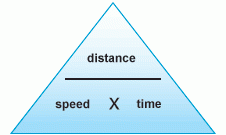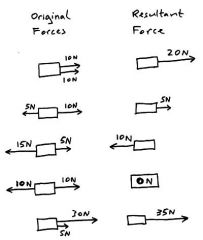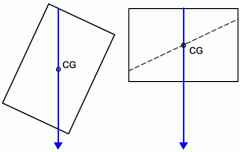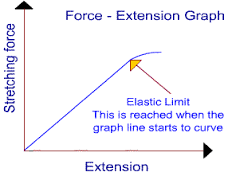![]()
![]()
![]()
Use LEFT and RIGHT arrow keys to navigate between flashcards;
Use UP and DOWN arrow keys to flip the card;
H to show hint;
A reads text to speech;
46 Cards in this Set
- Front
- Back
|
Physics IGCsE edexcel spec explained for me |
words and lyrics by black jerome with a lot of words and lyrics from other websites |
|
|
Section 1 Forces and motion a) Units 1.1 use the following units: kilogram (kg), metre (m), metre/second (m/s), metre/second2 (m/s2), newton (N), second (s), newton per kilogram (N/kg), kilogram metre/second (kg m/s). |
kilogram (kg)- the metric way of measuring mass metre (m)- the metric measure for distance; metre/second (m/s)- this is a measure of speed and velocity newton (N)- a newton is a measure of force second (s)- a second is measure of time newton per kilogram (N/kg)- is also a unit for acceleration because N=kg*m/s^2 so N/kg = m/s^2
|
|
|
b) Movement 1.2 plot and interpret distance-time graphs |
Plot time on the x axis and distance on the y axis. The gradient of the line represents the speed of an object. The steeper the gradient, the faster the object. If the line is going away from x-axis then the object is moving away from the start. If the line is going towards the x-axis then the object is moving towards the start. A horizontal line is a stationary object. |
|
|
1.3 know and use the relationship between average speed, distance moved and time |

Speed- m/s, km/h, km/s Time- s, h Distance- m, km
Other variations as well. |
|
|
1.4 describe experiments to investigate the motion of everyday objects such as toy cars or tennis balls |
Record readings for the time it takes a toy car to travel certain distances, repeating with different speeds. Plot the readings on a distance-time graphs and compare.
|
|
|
1.5 know and use the relationship between acceleration, velocity and time |
acceleration=Change in velocity/time a=(v-u)/t
v= final velocity u=initial velocity |
|
|
1.6 plot and interpret velocity-time graphs |
Y-axis is the velocity X-axis is time A negative velocity has an opposite direction a positive velocity The line represents acceleration and deceleration. If the line is straight then there is a constant acceleration. The steeper the line, the more rapid the acceleration. |
|
|
1.7 determine acceleration from the gradient of a velocity-time graph |
The gradient is worked out by calculcating change in y/ change in x. Or (final velocity-initial velocity)/ time taken |
|
|
1.8 determine the distance travelled from the area between a velocity-time graph and the time axis |
To work out the distance, find the area between the time axis and the line. To find the area of triangles, do 0.5*base*height. |
|
|
c) Forces, movement, shape and momentum 1.9 describe the effects of forces between bodies such as changes in speed shape or direction CHANGES IN SPEED |
Changes in speed A stationary object has equal forces acting on it from all sides, including gravity and an upward force from the surface. An accelerating object has a larger forward force than backward force. A decelerating object has a larger backward force than forward force. An object moving at a constant speed has equal forces acting on it which is why there is no change in speed. |
|
|
1.9 describe the effects of forces between bodies such as changes in speed shape or direction CHANGES IN SHAPE AND DIRECTION |
The direction of the object is based on the direction of the strongest force acting on it.
A change in shape affects momentum. If the force=change in momentum/time t |
|
|
1.10 identify different types of force such as gravitational or electrostatic |
Weight is a force due to gravity. Friction is a force due to moving surfaces rubbing. Electric forces exist between two charged objecrs. Magnetic forces exist between two magnetic objects. Tension is a stretching force (squashing is called compression). Thrust is a force produced by an engine. Drag is a force due to air resistance Upthrust is a floating force |
|
|
1.11 distinguish between vector and scalar quantities |
Vector- Has magnitude and a direction. For example velocity is a speed in a given direction.
Scalar-Has a magnitude. For example speed. |
|
|
1.12 understand that force is a vector quantity |
A force has a magnitude, for example 200N for weight. Weight has a direction as it acts downwards. If weight has a magnitude and a direction then it is a vector quantity. |
|
|
1.13 find the resultant force of forces that act along a line |

Resultant force is the overall force of the forces acting along a line. The arrows are in proportion to the magnitude of the force and its direction. |
|
|
1.14 understand that friction is a force that opposes motion |
Friction is a force that acts in the opposite direction to motion. |
|
|
1.15 know and use the relationship between unbalanced force, mass and acceleration |
F= m x a force = mass x acceleration |
|
|
1.16 know and use the relationship between weight, mass and g (gravitational acceleration) |
Weight = mass x g W = m x g |
|
|
1.17 describe the forces acting on falling objects and explain why falling objects reach a terminal velocity |
When an object starts to fall, it is accelerating because the force downwards, gravity, is greater than the force upwards, air resistance. As the fall continues, air resistance increases and eventually equals gravity. Equal opposing forces means the object is falling at a constant speed and its maximum speed. This is the terminal velocity of the object. |
|
|
1.18 describe experiments to investigate the forces acting on falling objects, such as sycamore seeds or parachutes |
Drop parachutes from a given height, timing how long it takes them to reach the ground. By changing the size of the parachute, the time it takes to reach the ground should change. Plot the results on a scatter graph with the y-axis being the surface area of the parachutes and the x-axis being time. You should see that the larger the parachute, the longer it takes to reach the ground. This is shown by the graph's positive correlation. |
|
|
1.19 describe the factors affecting vehicle stopping distance including speed, mass, road condition and reaction time |
Stopping distance is thinking distance and braking distance added together, things that effect this are: The speed of the car The weight of the car The condition of the road e.g. icy The condition of the driver e.g. drugged, tiredness (thinking distance). The condition of the brakes and tyres. Weather conditions. |
|
|
1.20 know and use the relationship between momentum, mass and velocity |
momentum = mass x velocity p = m x v |
|
|
1.21 use the idea of momentum to explain safety features |
resultant force = change in momentum / time By using this equation, if the time it takes for the momentum to change is increased, then the resultant force will decrease. Crumple zones and air bags in cars increase the time, reducing the resultant force in a car crash. |
|
|
1.22 use the conservation of momentum to calculate the mass, velocity or momentum of objects |
All momentum is conserved
Momentum before = momentum after
momentum = mass x velocity |
|
|
1.23 use the relation ship between force, change in momentum and time taken |
force = change in momentum / time taken |
|
|
1.24 demonstrate an understanding of Newton's third law |
Each force has an equal and opposite force. For example sitting on a chair has equal forces of your weight downwards on the chair, and the chair pushing you back up. |
|
|
1.25 know and use the relationship between the moment of a force and its distance from the pivot: |
moment = force x perpendicular distance from pivot
If a 5N weight is place 5m from a pivot then there will be a moment of 25Nm |
|
|
1.26 recall that the weight of a body acts through its centre of gravity |

Weight acts from an object's centre of gravity. |
|
|
1.27 know and use the principle of moments for a simple system of parallel forces acting in one plane |

For this object to stay balanced, the moments either side must be equal. Therefore, if 5 x 7= 35, 4 x d = 35. 35/4 = 8.75N That's how you work out the force. |
|
|
1.28 understand that the upward forces on a light beam, supported at its ends, vary with the position of a heavy object placed on the beam |
Upward forces on a light beam, that is supported on its ends, vary with the position of a weight on the beam. e.g. if a weight on a beam is increased, the upward force on the light beam would increase because the upward force has to equal the downward force |
|
|
1.29 describe experiments to investigate how extension varies with applied force for helical springs, metal wires and rubber bands |
Most common experiment Attach a spring to a newton meter and measure its length Add a 1N weight and measure again continue to add more weights taking measurements up to 10N By plotting a graph from the results from this you can see the extension increases with force; as each time a weight is added the spring gets longer. |
|
|
1.30 understand that the initial linear region of a force-extension graph is associated with Hooke's law |

Where the line is straight diagonal, there is linear corellation between force and extension, they increase at the same rate. The curve represents the elastic limit/potential. |
|
|
1.31 describe elastic behaviour as the ability of a material to recover its original shape after the forces causing deformation have been removed |
When you stretch an object like an elastic band or a spring, it will turn back to its original state after the forces have stopped stretching it.
If the object is stretched beyond its elastic limit then it will not go back. It loses its elastic behaviour. |
|
|
d) Astronomy 1.32 understand gravitational field strength, g, and recall that it is different on other planets and the moon from that on the Earth |
The force acting per unit mass at that point. N/kg or how strongly something pulls an object towards it. Therefore, the greater the mass, the greater the force. That is why the Earth with a bigger mass has the moon with a smaller mass orbiting it. Jupiter has a much greater mass than the Earth and so has a greater gravitational field strength. |
|
|
1.33 explain that gravitational force: causes moons to orbit planets causes the planets to orbit the sun causes artificial satellites to orbit the Earth causes comets to orbit the sun |
If an object is within the field of another objects gravitational force then it will travel around it in a path known as an orbit. In this way: |
|
|
1.34 describe the differences in the orbits of comets, moons and planets |
Planet: Approximately a circle, slightly squashed, elliptical Moons: Almost circular, but still elliptical Comets: Very elliptical |
|
|
1.35 use the relationship between orbital speed, orbital radius and time period |
The first half of the equation works out the circumference of the circle, this is the distance, which is then divided by the time. Orbital speed = 2× π ×orbital radius/ time period v = 2× π × r/ T Essentially speed=distance/time with the distance being a circle. |
|
|
1.36 understand that: the universe is a large collection of billions of galaxies a galaxy is a large collection of billions of stars our solar system is in the Milky Way galaxy |
the universe is a large collection of billions of galaxies a galaxy is a large collection of billions of stars our solar system is in the Milky Way galaxy
i understand |
|
|
Section 2: Electricity a) Units 2.1 use the following units for electricity |
Ampere (A)- current Coulomb (C)- charge Joule (J)- energy Ohm (Ω)- resistance Second (s)- time Volt (V)- potential difference, voltage Watt (W)- power |
|
|
b) Mains Electricity 2.2 understand and identify the hazards of electricity including frayed cables, long cables, damaged plugs, water around sockets, and pushing metal objects into sockets |
Frayed cabling has damaged insulation exposing live wires which can give severe electrical shocks if touched. Long cables means a bigger chance of them getting damaged, exposing live wires and people tripping over them. Damaged plugs: can cause sparks or fires, exposed wires as well Water around sockets conducts large currents of electricity which would electrocute you if touched. Metal conducts electricity, which would electrocute you if touched. |
|
|
2.3 understand the uses of insulation, double insulation, earthing, fuses and circuit breakers in a range of domestic appliances |
Insulation:Covering a live wire in a non-conductive material. Double Insulation: These appliances have plastic casings or the live wire cannot touch the casing so even if there are loose wires, they won't give an electric shock. Earthing: An earth wire has a very low resistance and is touching the casing so any current in a metal casing will travel down the earth wire or break the fuse. |
|
|
2.3 understand the uses of insulation, double insulation, earthing, fuses and circuit breakers in a range of domestic appliances CONTINUED FUSES AND CIRCUIT BREAKERS |
Fuses: sections of wire in the circuit that melt if too high a current goes through them. They come with different maximum currents. Circuit breakers: Has an electromagnet that is activated if the current goes above a certain limit. the electromagnet pulls an iron switch towards it, this opens the switch and breaks the circuit. |
|
|
2.4 understand that a current in a resistor results in the electrical transfer of energy and an increase in temperature, and how this can be used in a variety of domestic contexts |
As a resistor slows down the movement of electrons, the kinetic energy that was moving them is converted into heat energy. This can be used, for example, in hair dryers or heaters.
|
|
|
2.5 know and use the relationship for power current and voltage |
P = I x V power = current x voltage |
|
|
2.6 use the relationship between energy transferred, current, voltage and time |
Energy transferred = current x voltage x time E = I x V x t
because P = I x V, E= P x t |
|
|
2.7 understand the difference between mains electricity being alternating current (a.c.) and direct current (d.c.) being supplied by a cell or battery |
fa |

